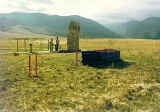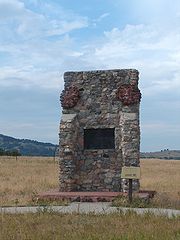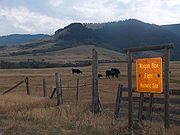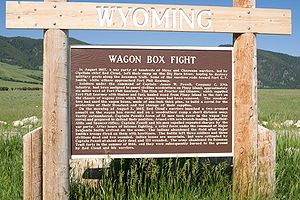
Wagon Box Fight
Encyclopedia
The Wagon Box Fight was an engagement on August 2, 1867, during Red Cloud's War
between the U.S. Army and Lakota (Sioux) Native Americans in the vicinity of Fort Phil Kearny
, Wyoming
.
, bands of Oglala
Lakota under Red Cloud
and the other Powder River
Sioux joined with Northern Cheyenne at their Tongue River
and Rosebud River camps, where they resolved to destroy nearby Fort C.F. Smith and Fort Phil Kearny, against which they had been engaged for a year to prevent travel on the Bozeman Trail
. Unable to resolve which to destroy first, the bands split into two large bodies, with approximately 500-800 Cheyenne and Sioux moving against Fort C.F. Smith and the rest, possibly including Red Cloud, headed to Fort Phil Kearny.
warriors under the leadership of Crazy Horse
and High Back-Bone and a smaller party of Cheyenne
warriors under Little Wolf
near Fort Phil Kearny
, Wyoming Territory
, along the Bozeman Trail
. Red Cloud's presence at the battle remains in doubt. One of Powell's junior officers at the battle, Lt. John C. Jenness, reportedly saw Red Cloud at a distance through field glasses, but such an identification is questionable.
Powell's defenders, acting as guards for civilian crews cutting wood for the construction of the fort, had been sent out early in the morning. Two men went to look for game, but instead spotted a huge force of Sioux. Powell's men took refuge in a corral formed by laying 14 wagons end-to-end in an oval configuration. The battle lasted five hours, with Powell losing five men killed and two wounded. Powell reported killing 60 Indians and wounding 120 (although published accounts have put the number of casualties as high as eleven hundred). The disproportionate casualties, and the soldiers survival, was primarily due to the recent issue of Springfield Model 1866
"Trapdoor" .50-caliber breech-loading
rifles, that had been supplied as a direct result of the Fetterman massacre. Indian attack strategy had been based on the long reloading time of muzzle-loading weapons. The fight lasted throughout the day until a relief force from Fort Phil Kearny
finally arrived and the attackers withdrew.
The day before, on August 1, the second group had struck at Fort C.F. Smith and suffered an almost identical repulse in the Hayfield Fight
.



Red Cloud's War
Red Cloud's War was an armed conflict between the Lakota, Northern Cheyenne, and Arapaho and the United States in the Wyoming Territory and the Montana Territory from 1866 to 1868. The war was fought over control of the Powder River Country in north central present day Wyoming...
between the U.S. Army and Lakota (Sioux) Native Americans in the vicinity of Fort Phil Kearny
Fort Phil Kearny
Fort Phil Kearny was an outpost of the United States Army that existed in the late 1860s in present-day northeastern Wyoming along the Bozeman Trail. Construction began Friday July 13, 1866 by Companies A, C, E and H of the 2nd Battalion, 18th Infantry, under the direction of the regimental...
, Wyoming
Wyoming
Wyoming is a state in the mountain region of the Western United States. The western two thirds of the state is covered mostly with the mountain ranges and rangelands in the foothills of the Eastern Rocky Mountains, while the eastern third of the state is high elevation prairie known as the High...
.
Background
In July 1867, after their annual sun danceSun Dance
The Sun Dance is a religious ceremony practiced by a number of Native American and First Nations peoples, primarily those of the Plains Nations. Each tribe has its own distinct practices and ceremonial protocols...
, bands of Oglala
Oglala
Oglala may refer to:* Oglala Lakota, or Oglala Sioux, a Sioux Nation sub-band of the Western division * The Oglala National Grassland of Nebraska* Oglala, South Dakota, a town located in Shannon County, South Dakota...
Lakota under Red Cloud
Red Cloud
Red Cloud , was a war leader and the head Chief of the Oglala Lakota . His reign was from 1868 to 1909...
and the other Powder River
Powder River (Montana)
Powder River is a tributary of the Yellowstone River, approximately long in the southeastern Montana and northeastern Wyoming in the United States. It drains an area historically known as the Powder River Country on the high plains east of the Bighorn Mountains.It rises in three forks in eastern...
Sioux joined with Northern Cheyenne at their Tongue River
Tongue River
The Tongue River may refer to:*The Tongue River , a tributary of the Red River of the North in North Dakota in the United States.*The Tongue River , a tributary of the Yellowstone in Wyoming and Montana in the United States....
and Rosebud River camps, where they resolved to destroy nearby Fort C.F. Smith and Fort Phil Kearny, against which they had been engaged for a year to prevent travel on the Bozeman Trail
Bozeman Trail
The Bozeman Trail was an overland route connecting the gold rush territory of Montana to the Oregon Trail. Its most important period was from 1863-1868. The flow of pioneers and settlers through territory of American Indians provoked their resentment and caused attacks. The U.S. Army undertook...
. Unable to resolve which to destroy first, the bands split into two large bodies, with approximately 500-800 Cheyenne and Sioux moving against Fort C.F. Smith and the rest, possibly including Red Cloud, headed to Fort Phil Kearny.
The fight
On August 2, 1867, Capt. James Powell with a force of 31 soldiers from the U.S. Army's 9th Infantry survived repeated attacks by one to two thousand SiouxSioux
The Sioux are Native American and First Nations people in North America. The term can refer to any ethnic group within the Great Sioux Nation or any of the nation's many language dialects...
warriors under the leadership of Crazy Horse
Crazy Horse
Crazy Horse was a Native American war leader of the Oglala Lakota. He took up arms against the U.S...
and High Back-Bone and a smaller party of Cheyenne
Cheyenne
Cheyenne are a Native American people of the Great Plains, who are of the Algonquian language family. The Cheyenne Nation is composed of two united tribes, the Só'taeo'o and the Tsétsêhéstâhese .The Cheyenne are thought to have branched off other tribes of Algonquian stock inhabiting lands...
warriors under Little Wolf
Little Wolf
Little Wolf was a Northern Cheyenne Chief...
near Fort Phil Kearny
Fort Phil Kearny
Fort Phil Kearny was an outpost of the United States Army that existed in the late 1860s in present-day northeastern Wyoming along the Bozeman Trail. Construction began Friday July 13, 1866 by Companies A, C, E and H of the 2nd Battalion, 18th Infantry, under the direction of the regimental...
, Wyoming Territory
Wyoming Territory
The Territory of Wyoming was an organized incorporated territory of the United States that existed from July 25, 1868, until July 10, 1890, when it was admitted to the Union as the State of Wyoming. Cheyenne was the territorial capital...
, along the Bozeman Trail
Bozeman Trail
The Bozeman Trail was an overland route connecting the gold rush territory of Montana to the Oregon Trail. Its most important period was from 1863-1868. The flow of pioneers and settlers through territory of American Indians provoked their resentment and caused attacks. The U.S. Army undertook...
. Red Cloud's presence at the battle remains in doubt. One of Powell's junior officers at the battle, Lt. John C. Jenness, reportedly saw Red Cloud at a distance through field glasses, but such an identification is questionable.
Powell's defenders, acting as guards for civilian crews cutting wood for the construction of the fort, had been sent out early in the morning. Two men went to look for game, but instead spotted a huge force of Sioux. Powell's men took refuge in a corral formed by laying 14 wagons end-to-end in an oval configuration. The battle lasted five hours, with Powell losing five men killed and two wounded. Powell reported killing 60 Indians and wounding 120 (although published accounts have put the number of casualties as high as eleven hundred). The disproportionate casualties, and the soldiers survival, was primarily due to the recent issue of Springfield Model 1866
Springfield Model 1866
The Springfield Model 1866 was the second iteration of the Allin-designed trapdoor breech-loading mechanism. Originally developed as a means of converting rifled muskets to breechloaders, the Allin modification ultimately became the basis for the definitive Model 1873, the first breech-loading...
"Trapdoor" .50-caliber breech-loading
Breech-loading weapon
A breech-loading weapon is a firearm in which the cartridge or shell is inserted or loaded into a chamber integral to the rear portion of a barrel....
rifles, that had been supplied as a direct result of the Fetterman massacre. Indian attack strategy had been based on the long reloading time of muzzle-loading weapons. The fight lasted throughout the day until a relief force from Fort Phil Kearny
Fort Phil Kearny
Fort Phil Kearny was an outpost of the United States Army that existed in the late 1860s in present-day northeastern Wyoming along the Bozeman Trail. Construction began Friday July 13, 1866 by Companies A, C, E and H of the 2nd Battalion, 18th Infantry, under the direction of the regimental...
finally arrived and the attackers withdrew.
The day before, on August 1, the second group had struck at Fort C.F. Smith and suffered an almost identical repulse in the Hayfield Fight
Hayfield Fight
The Hayfield Fight was an engagement of Red Cloud's War on August 1, 1867, between troops of the U.S. Army and Native American Indians, mostly Cheyenne warriors.-Background:...
.
External links



- http://www.globalsecurity.org/military/agency/army/2-9inf.htm
- Fort Phil Kearny State Historic Site
- A detailed, first-hand account of the fight
- Wyoming State Parks - Wagon Box Fight details, list of participants
- Wyoming Tales and Trails - Good information and Photos

